Mice
Mice: When, Where, Who, What, How & Why
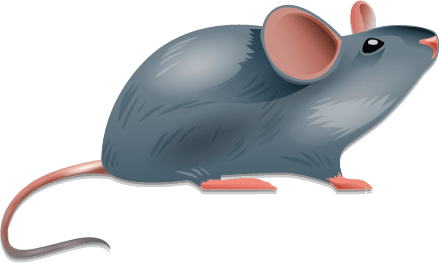
When & Where Mice Are Most Problematic

Data pulled from our Pest Prediction Tool
Who’s the problem here?

The adult house mouse is small and slender and about one to two inches long, excluding its tail. The tail is as long as the head and body combined. It has large ears, a pointed nose and small eyes. The fur color varies, but it is usually a light grey or brown, but could be darker shades. You can tell them apart from native mice by their almost furless ears and scaly tails. They are good climbers, swimmers, and jumpers. They can run as fast as 8 miles per hour. Even so, they seldom travel farther than 50 feet from their homes.
Mice are considered nibblers, eating at many times and at different places. Mice will snack every one to two hours throughout the day. However, they do have two main meal times, one just before dawn and the other at dusk. They can eat about 10% to 15% of their body weight every day, the adults weighing about 5/8-1 oz. Mice droppings are about 1/8-1/4 inch long and rod shaped. They gnaw small, clean holes about 1-1/2 inches in diameter. Many times in kitchens you will find gnawing damage on the corner of boxes and paper which is shredded for their nest.
What About Mice…?
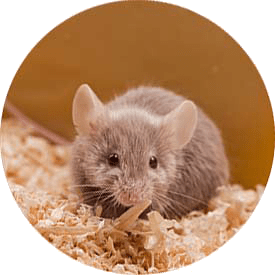
Mice will eat almost anything (including soap & glue), but prefer cereal grains, seeds, or sweet material. They require very little water, obtaining most of their water needs from their food. If there are good living conditions (food, water, and shelter), they can multiply rapidly. They sexually mature in two months, producing about eight litters in a one year life time. Each litter has four to seven pups. House mice in a city environment may spend their entire life in buildings. In rural and suburban settings, mice may not only live inside, but be found outside near foundations, in shrubbery, weeds, crawl spaces, basements, or in garages. They survive well on weeds, seeds, or insects, but when their food supply is shortened by the colder months they move inside nesting closer to a food supply. They make their nest from soft material like paper, insulation, or furniture stuffing. These nests can be found in many places including walls, ceiling voids, storage boxes, drawers, under major appliances, or within the upholstery of furniture. Outside nests are found in debris or in ground burrows.
How do Mice Become A Problem?
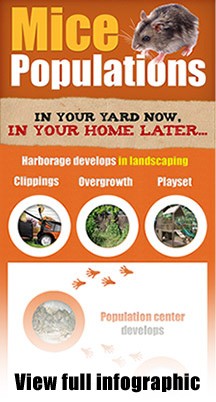
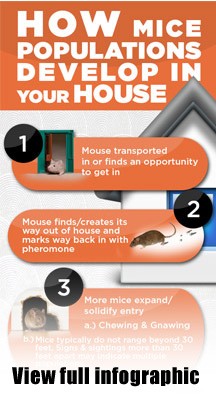

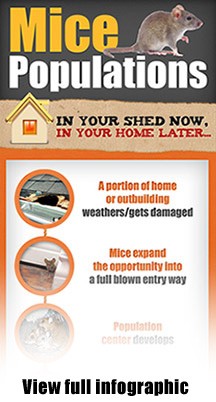
Arizona Mice Control Service Areas
Massachusetts Mice Control Service Areas
- Mice Control in Framingham, MA
- Mice Control in Marlborough, MA
- Mice Control Milford, MA
- Mice Control in Shrewsbury, MA
- Mice Control in Southborough, MA
- Mice Control in Wellesley, MA
Michigan Mice Control Service Areas
- Mice Control in Commerce Charter Township, MI
- Mice Control in Detroit, MI
- Mice Control in Farmington Hills, MI
- Mice Control in Milford, MI
- Mice Control in Novi, MI
- Mice Control in Plymouth, MI
- Mice Control in South Lyon, MI
- Mice Control in Wixom, MI
Minnesota Mice Control Service Areas
- Mice Control in Lakeview, MN
- Mice Control in Brooklyn Park, MN
- Mice Control in Champlin, MN
- Mice Control in Eagan, MN
- Mice Control in Edina, MN
- Mice Control in Golden Valley, MN
- Mice Control in Inver Grove Heights, MN
- Mice Control in Minneapolis-St.Paul, MN
- Mice Control in Oakdale, MN
- Mice Control in Plymouth, MN
- Mice Control in Rochester, MN
- Mice Control in Roseville, MN
- Mice Control in Shoreview, MN
Wisconsin Mice Control Service Areas
- Mice Control in Fitchburg, WI
- Mice Control in Hudson, WI
- Mice Control in Madison, WI
- Mice Control in McFarland, WI
- Mice Control in Middleton, WI
- Mice Control in Sun Prairie, WI
- Mice Control in Verona, WI
Why Eliminate The Mouse Problem In Your Home?
Health Concerns Stem From:
- Urine
- Feces
- Saliva
- traveling through cupboards, bathrooms, garbage, pantry-in same route
Potential Diseases Mice Can Cause/Spread:
- salmonella
- rickettsial pox
- meningitis
- leptospirosis (weil’s disease)
- Rat bite fever
- ray fungus
- ringworm
- dermatitis
If you’re experiencing any problems with mice, call the pest control professionals at Rove: 651-433-6355. A friendly pest control expert from one of our 4 Minnesota offices (in St. Paul, Minneapolis, Oakdale & Brooklyn Park) will be able to help.
